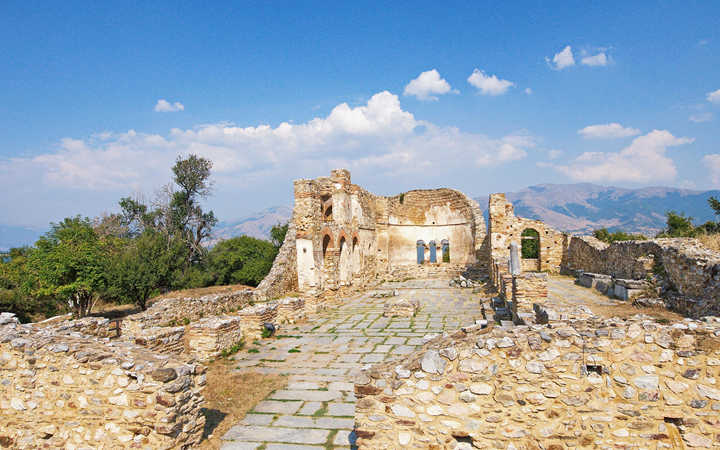Agios Germanos is a mountain village located in Florina region (nome), which was previously the center of the Prespa region.
It is located almost on the border between Greece and the Former Yugoslav Republic of Macedonia (FYROM) - above Lake Big Prespa - at an altitude of 1040 meters above sea level, 48 kilometers from the city of Florina and 54 kilometers from Kastoria.
The village of Agios Germanos is part of the municipality of Prespa. The current inhabitants of the village were moved here to a settlement in 1952-1954 - after the Civil War that erupted in Greece after the Second World War. During the war years the area was literally devastated: before the Civil War the village had 3,500 inhabitants then after it only 250 people remained in the village.
According to assumptions, the foundation of the village dates back to the 10th century, when a church was erected here. During the Ottoman rule, the village was called German, and since 1926 it was renamed Agios Germanos (St. Germanos).
Agios Germanos is the birthplace of many fighters for the liberation of Macedonia (“Macedonomachoi”) - Spyros Paraskevaidis, Alexios Aleksoudis, Ioannis Damoulis, Nikolaos Kutsukis, Stergios Misios, Konstantinos Naidos and Eleni Hadzopulu.
Among the sights of the village, the cross-shaped domed church of Agios Germanos (St. German), built in the 11th century in honor of the patriarch of Constantinople Germanos (640-735). Murals dating to the 11th, 13th and 18th centuries are preserved to this day and deserves attention. Here you can also visit the eponymous, later, parish church, built in 1882. In the village there is another, quite old church - the church of St. Athanasius (XVII century). Every year on April 23 and May 12 - in the days of memory of St. George and St. Germanos - a church holiday (panigiri) is held on the village square.
The most beloved dances of the locals are “litos” (the national dance of Macedonia) and “ipyrotic” (dances of mainland Greece).
There is a traditional distillery to produce tsipouro - Greek brandy from squeezed grapes. In general, the whole village is of great interest from the architecture point of view. Many of the houses preserved here were built before the Second World War.
In addition, the Children's Library is located in Agios Germanos. The Culture Society and the Prespa Preservation Organization are doing a lot in terms of the development of this region. There is also an Information Center that provides data on the natural environment - from the number of birds in the area to organized excursions with professional guides.
The main occupations of the villagers are agriculture, animal husbandry and tourism.
On the European path E6, passing through the region, there are springs "Motsara" and "Potistra". In addition, the area also has other springs such as Filakio, Prosilio and Jovanica.
The Paliorema River flows through the village with 5 old bridges survived to this day.
An amazing panorama opens from the mountain peaks of Varnunda Kirko (2.156 m), Kitsevo (2.334 m), Kotsifas (2.066 m), Gaidouritsa, Bella Voda (2.177 m) and Jovanitsa (2.125 m).
At an altitude of 1,100 meters above sea level is the Hotel Petrino, laid out in a traditional style of stone (“Petrino” means “building made of stone” in Greek). Not only the building itself corresponds to the principles of tradition, but even the services provided here: for example, the hotel owners present amazingly delicious cakes made according to local recipes for breakfast!
The location of the hotel allows visitors to take many interesting excursions or organize independent walks. In fact, Petrino is a real mountain haven within the limits of virgin nature, which operates all year round!
And it is no coincidence, because nowadays tourism is getting more and more development in the village due to its location to the Prespes National Park.












